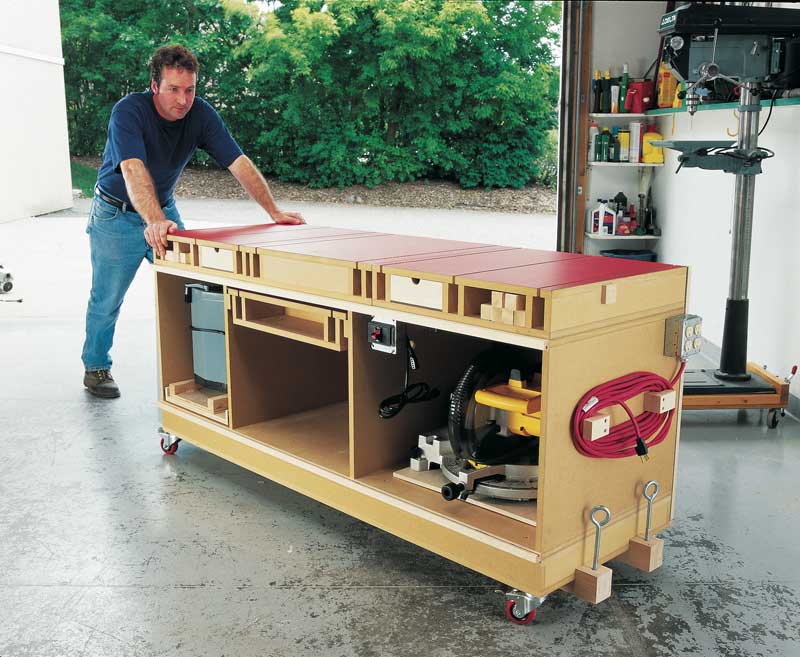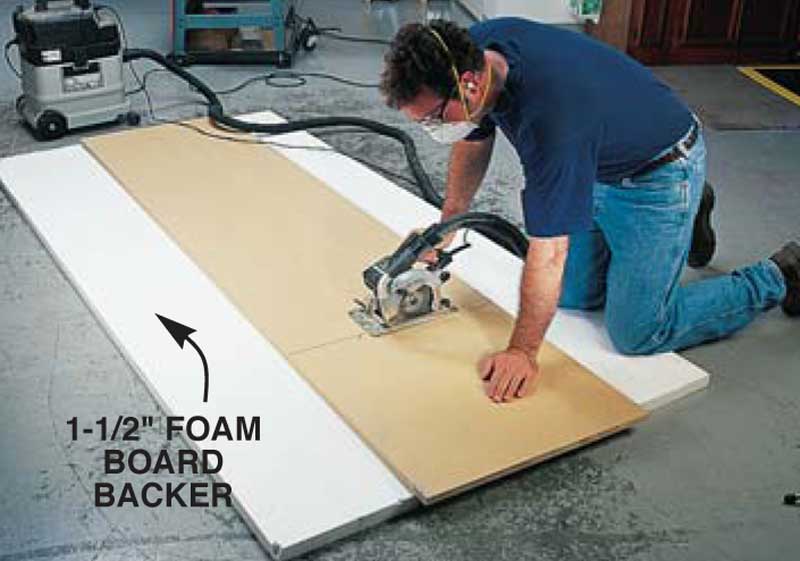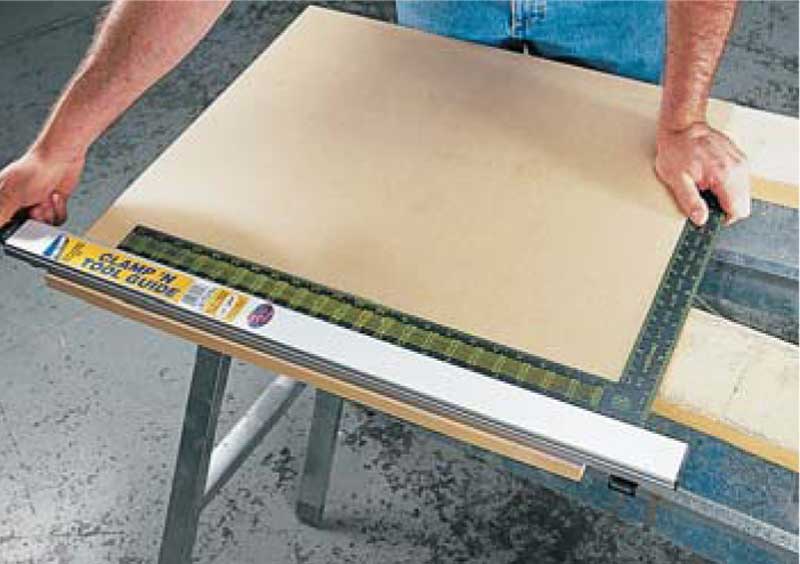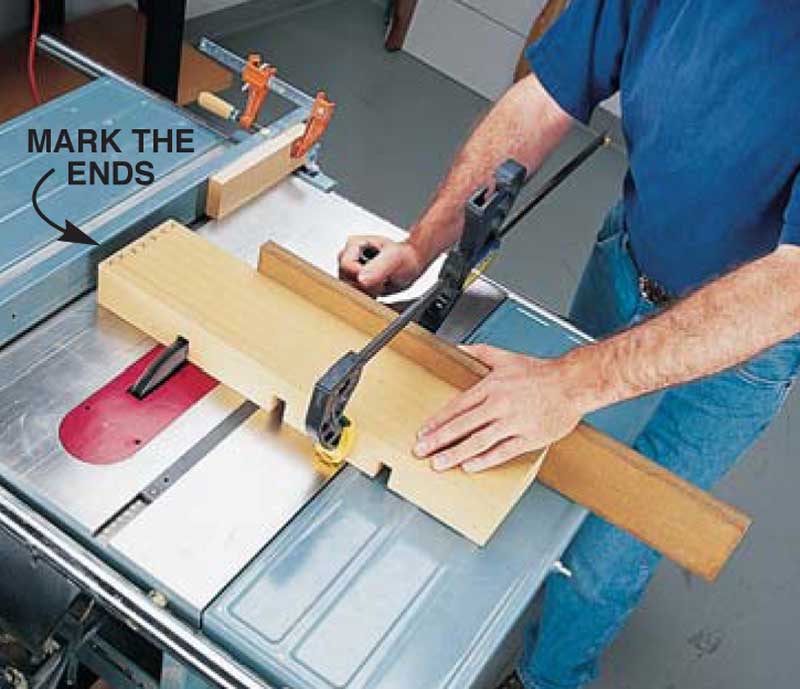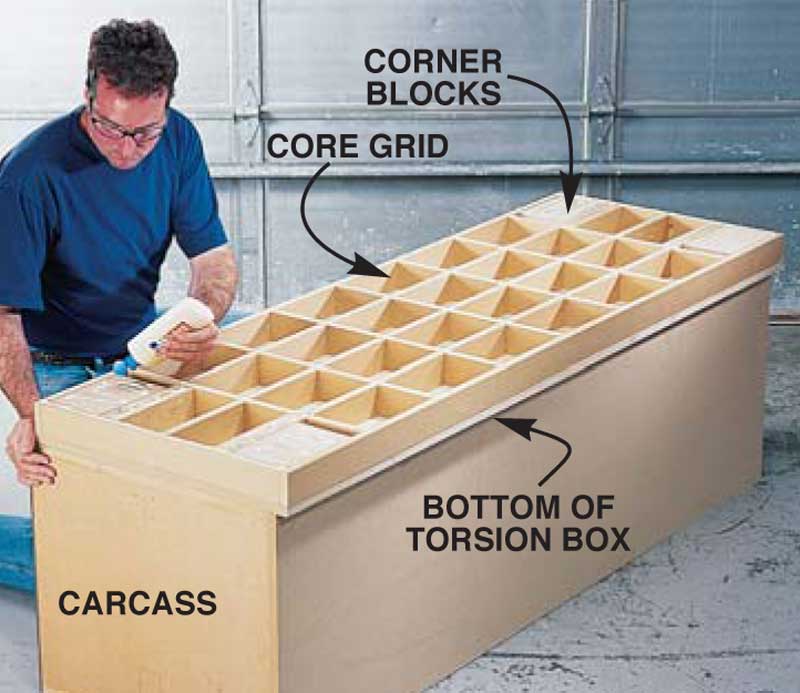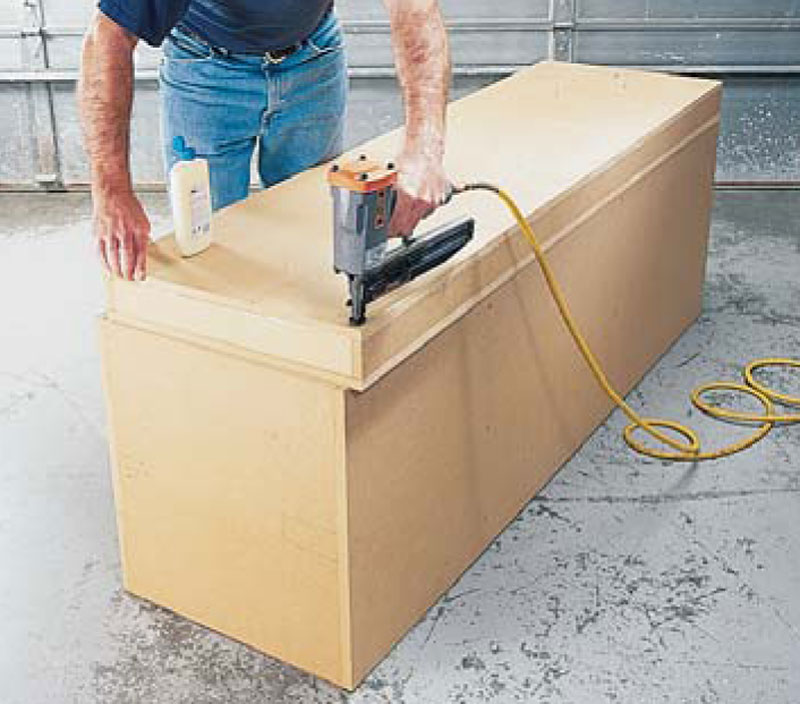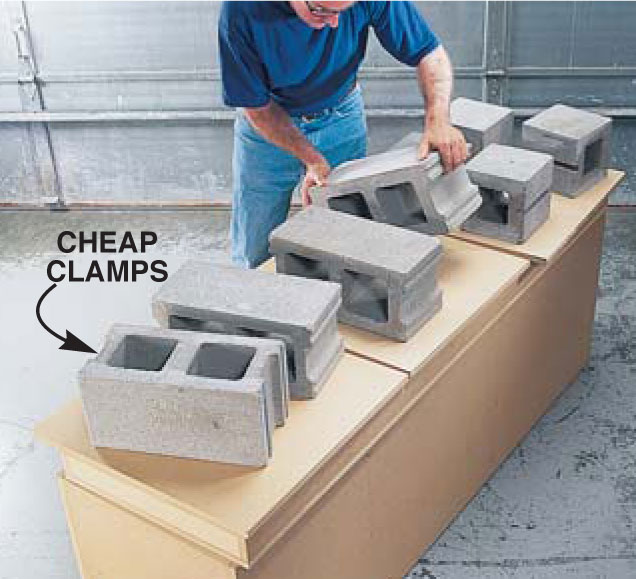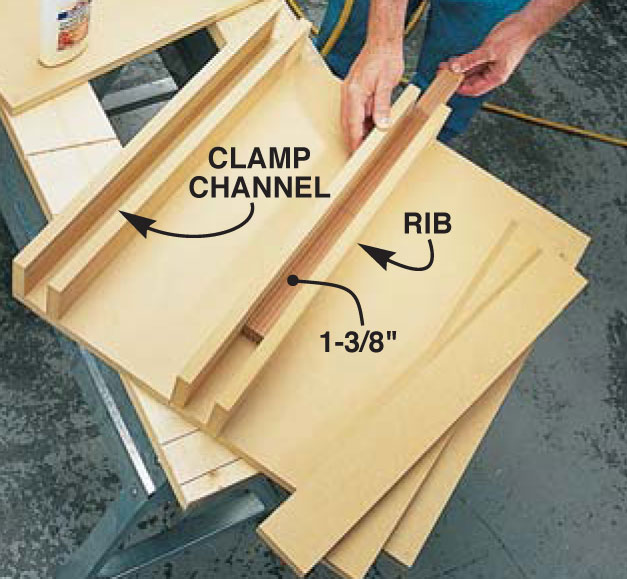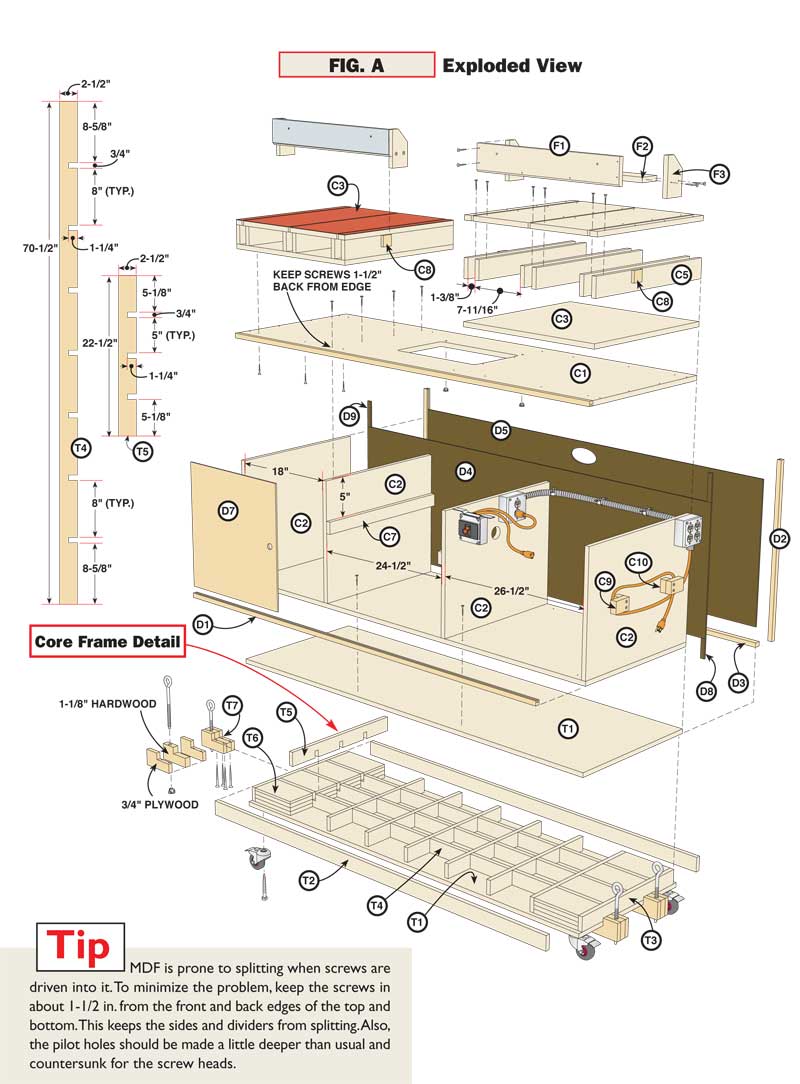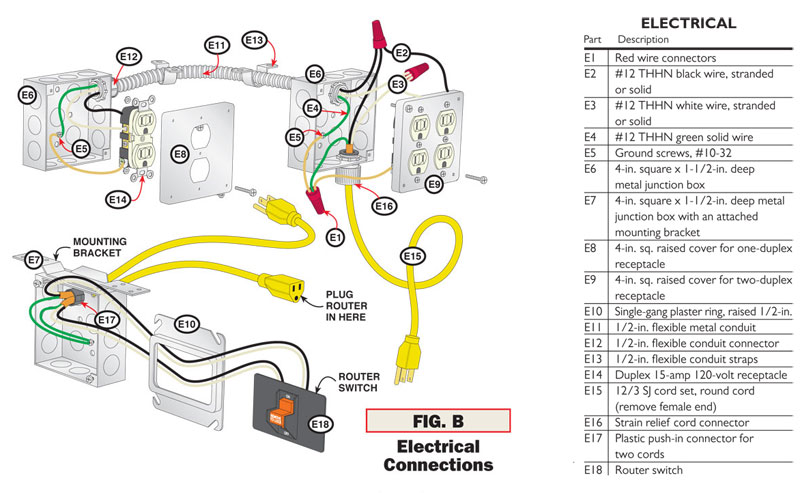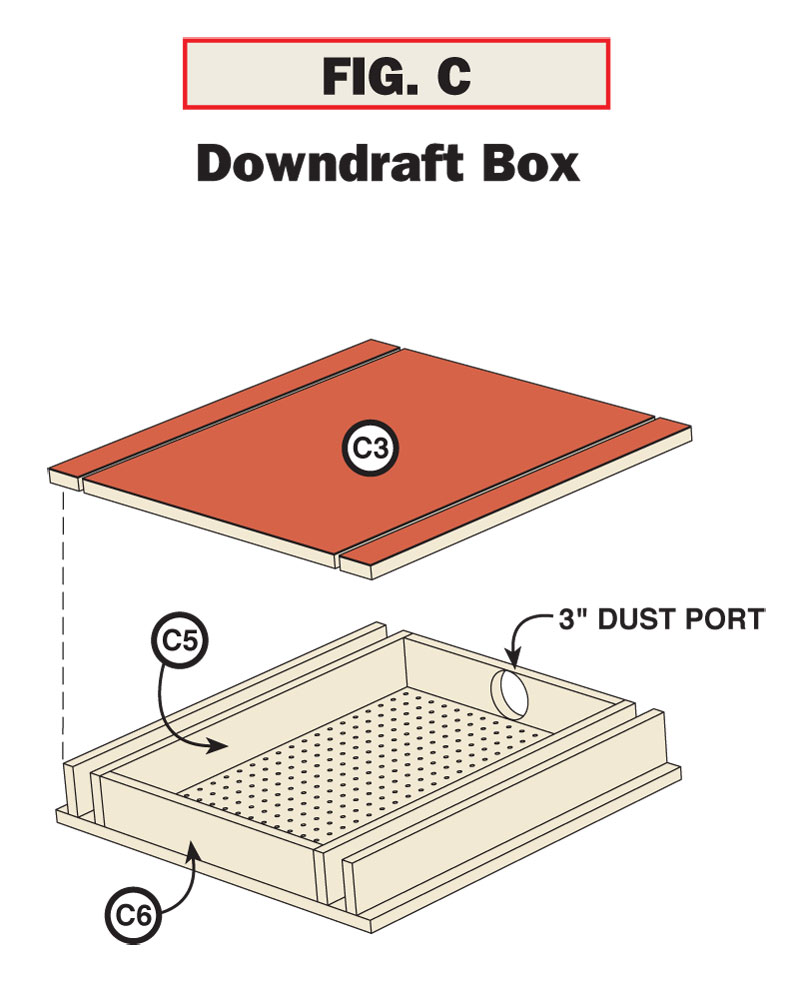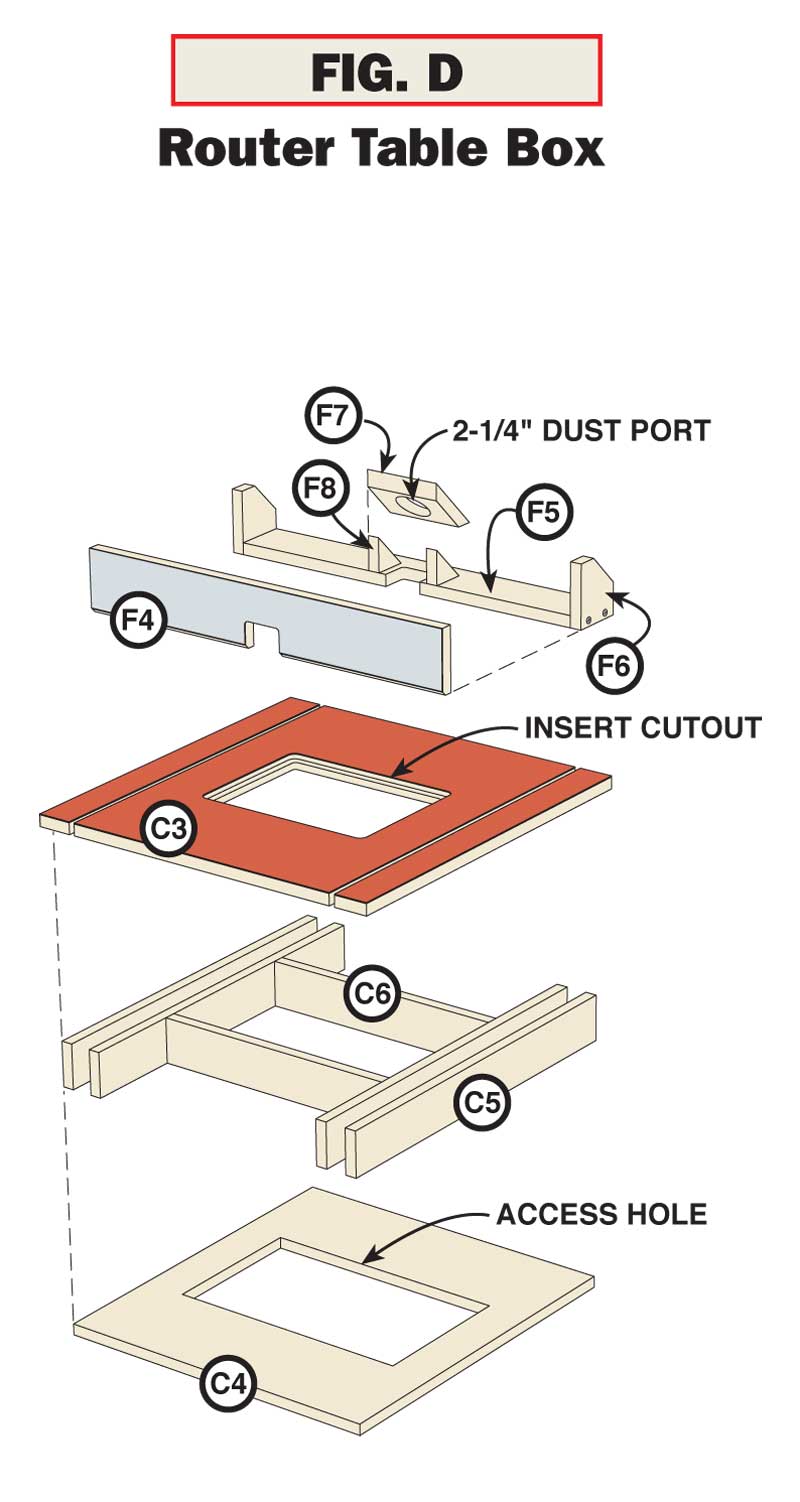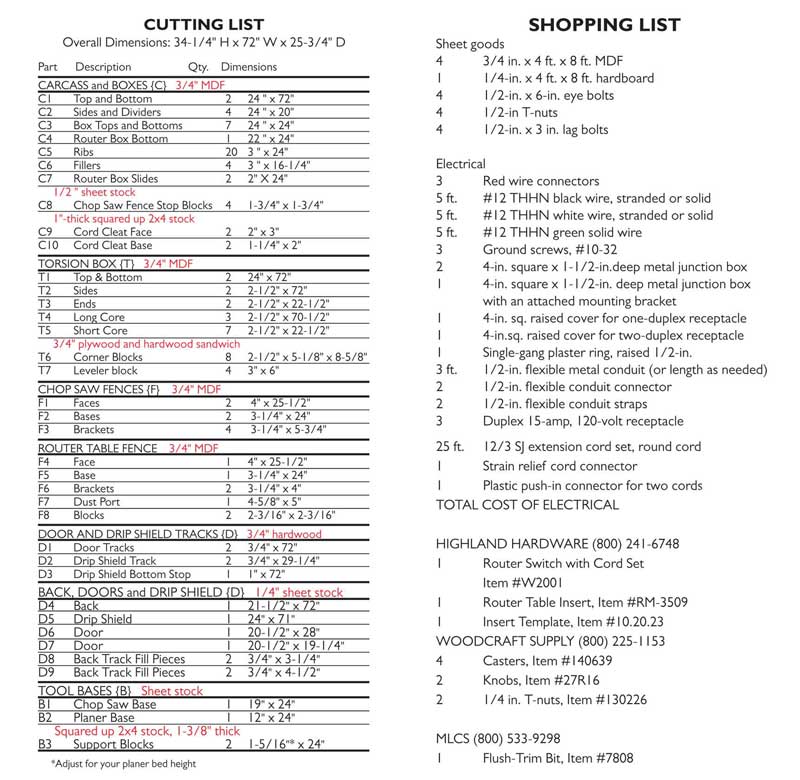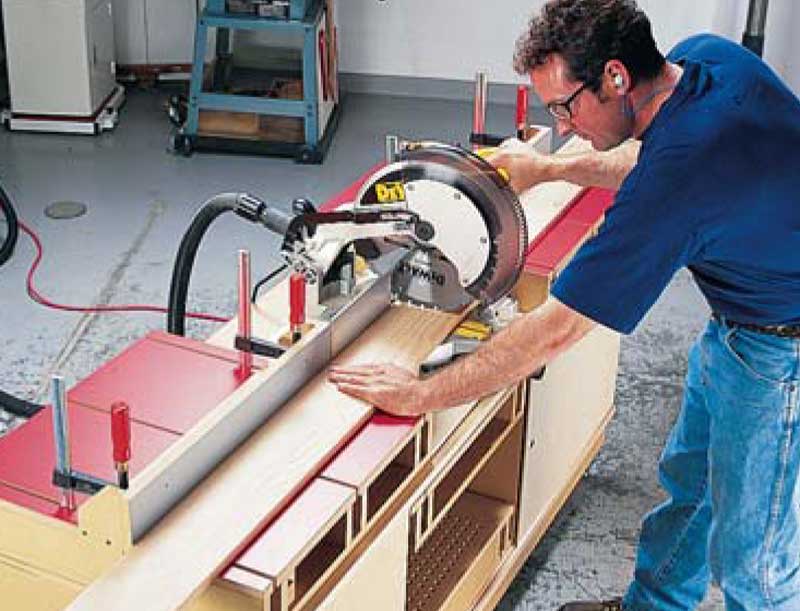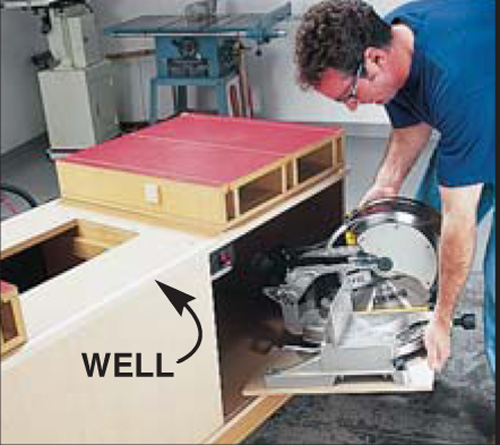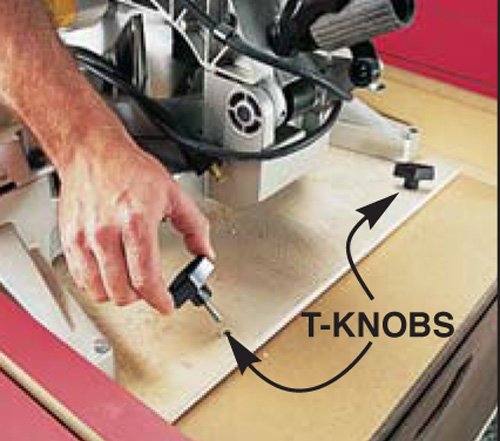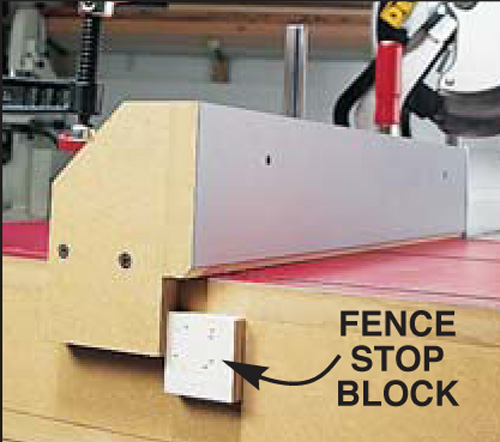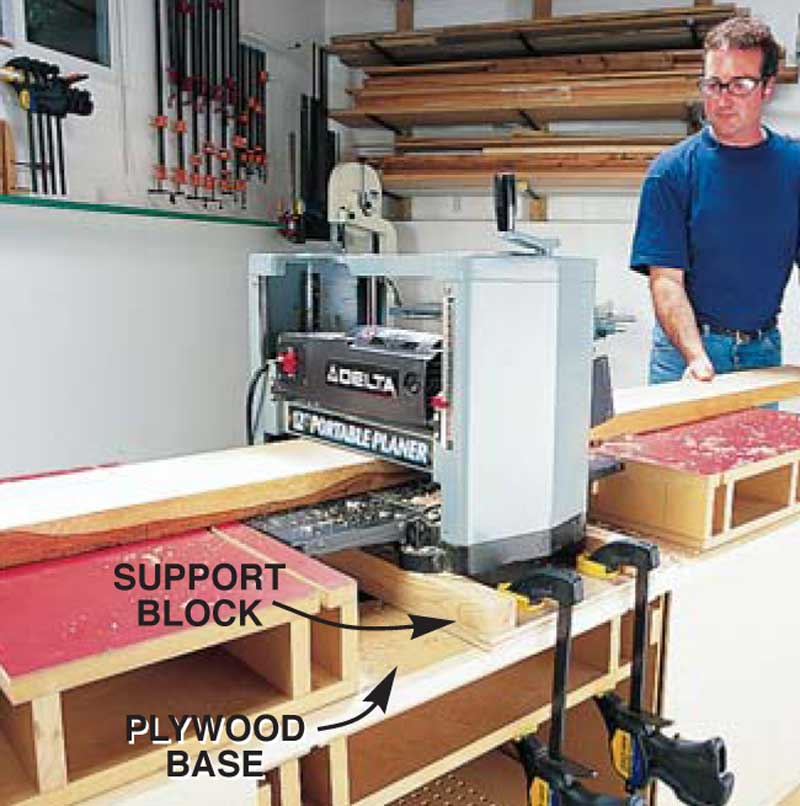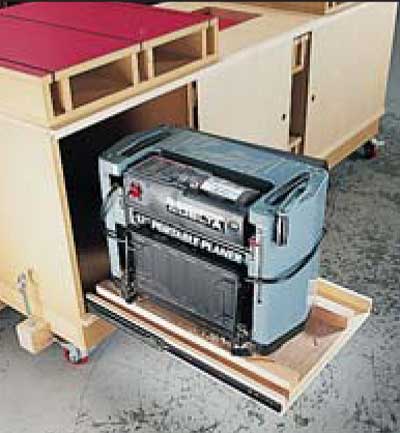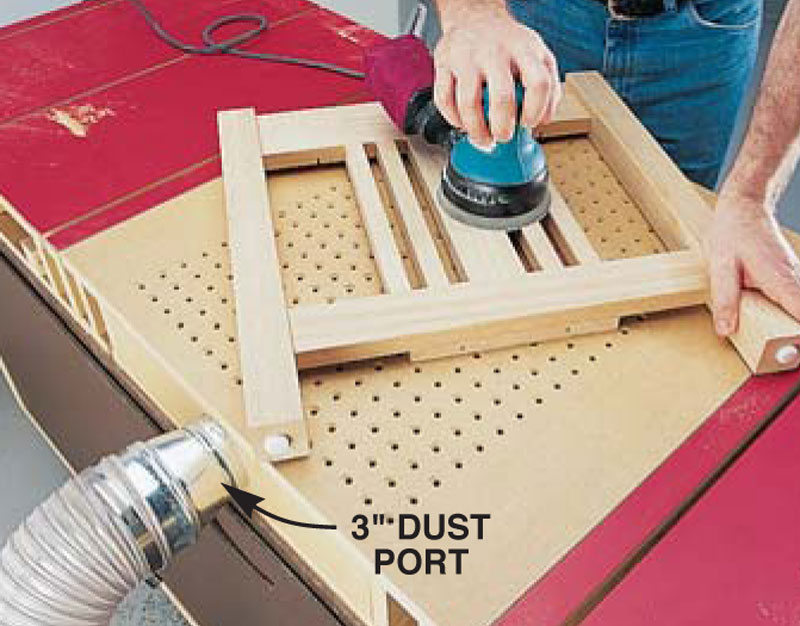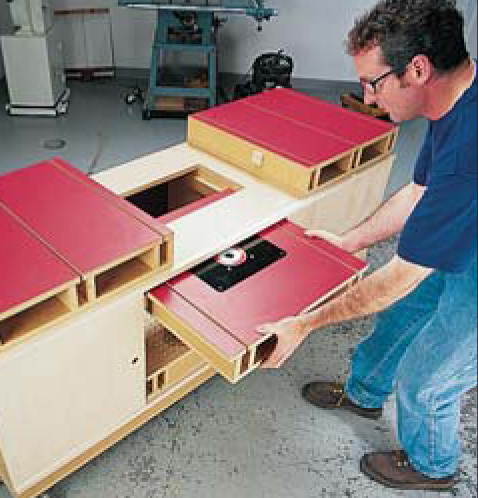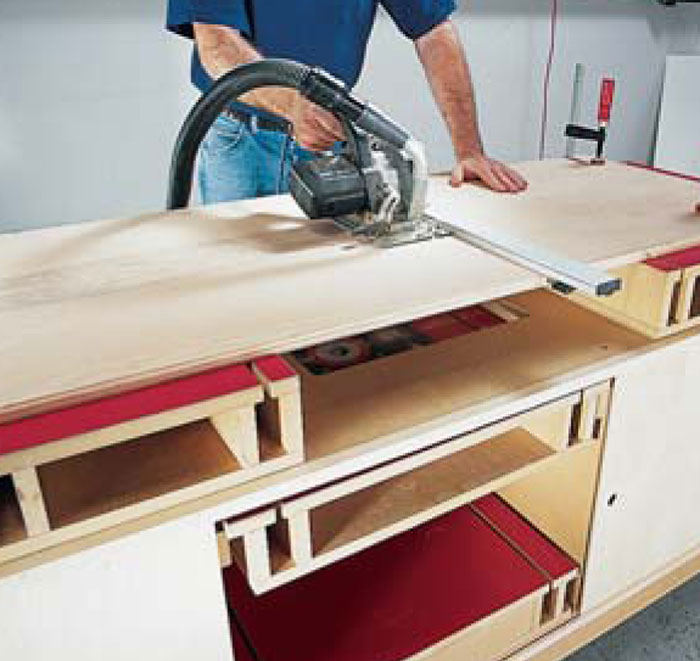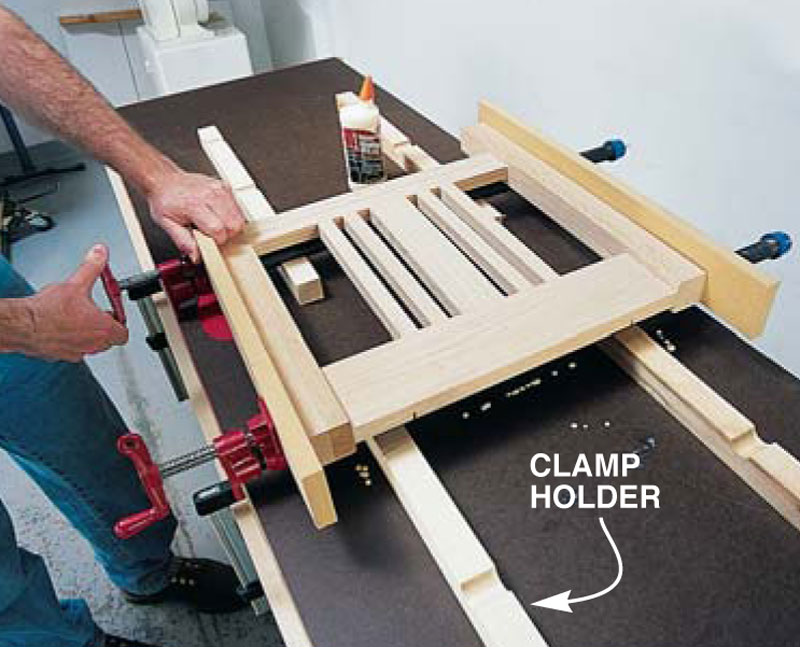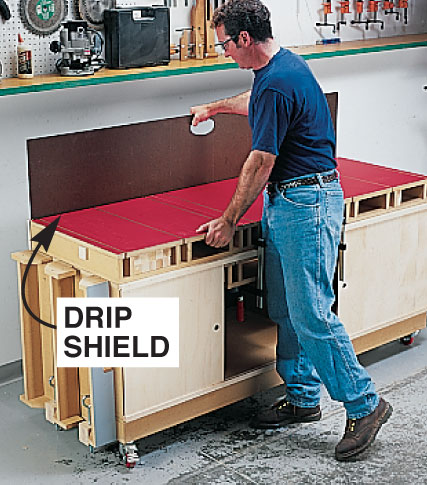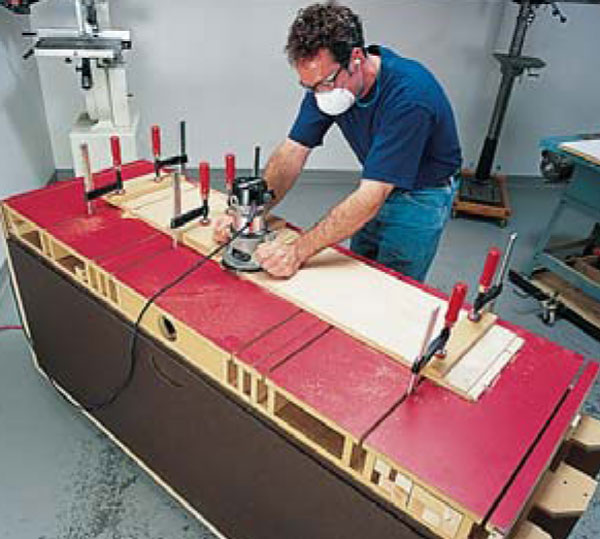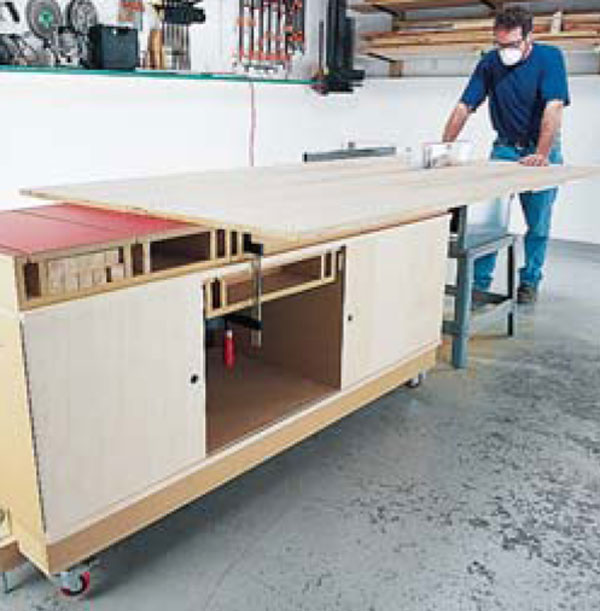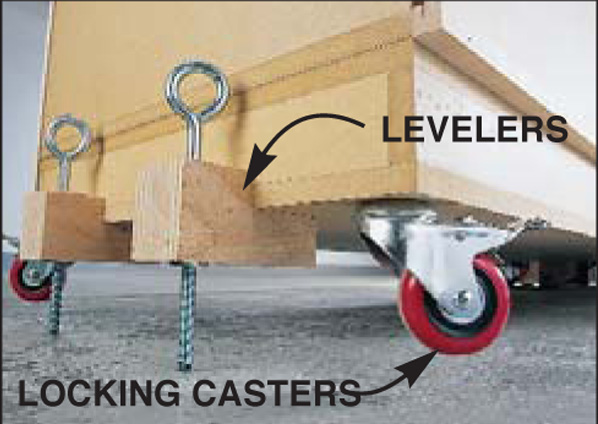We may receive a commission when you use our affiliate links. However, this does not impact our recommendations.
Ultimate Tool Stand
An easy-to-use space saver with more functions than a Swiss army knife.
By Dave Munkittrick
For those of us who share shop space with a car or a washer and dryer, elbowroom is always a problem. This tool stand is the answer. A 2 ft.by 6-ft. section of floor space is all you need to store it. When you’re ready to work, just roll it out, lock it down (these casters won’t budge) and plug it in. It not only stores three benchtop power tools, it provides a working platform that actually improves their performance. In seconds you can shift from a chop saw station to a huge router table and then to a portable planer stand with infeed and outfeed support.
A dead-flat torsion box is the foundation of this tool stand. This torsion box is a sandwich made from two skins of medium-density fiberboard (MDF) and a grid core (Fig.A). It offers incredible strength and resistance to sagging. It simply won’t twist out of shape no matter how uneven your shop floor is.
Getting Started
$300 buys all the material you need to construct the ultimate tool stand.We used 3/4-in.MDF to build ours.
The only tools you need are a circular saw, a router, a drill, a tablesaw and an accurate straightedge.A pneumatic nail gun makes assembly a lot easier.
Butt joints, screws and glue make for simple, sturdy construction.
Dimensioning the Tool Stand
There are two things to consider when dimensioning your tool stand:
1. The height of the bed on your chop saw.
2. The height of your tablesaw.
The tool stand consists of two boxes permanently fixed to the top to form a tool well (Fig.A). The 4-1/2-in. height of each box was determined by the height of our chop saw’s bed mounted on a 1/2-in.plywood base.Adjust the width of the ribs (C5) to match the height of your own chop saw. The 34-in.height of the tool stand is just below our tablesaw so it can be used as an outfeed table. If you need a different height for your saw, adjust the length of the sides and dividers (C2) accordingly.
Accurate Machining of Parts
Any part that’s a little bit out of square or not exactly the right size will have a ripple effect on the outcome of this project. Sides and dividers that are not square or exactly the same size will result in an uneven top.Out-of-square tops and bottoms make for poor-fitting inserts.
The Square Template
Here’s a recipe to guarantee square, perfectly sized parts:
First, rough cut the tops, bottoms and sides about 1/2-in. oversize with a circular saw (Photo 1). Then rip all the pieces to finish width on your tablesaw.Organize your work so the fence is set just once for each dimension. This guarantees that every piece is exactly the same width.
Each piece must be crosscut perfectly square.One surefire way to get a square end is to use a straightedge and a router with a flush-trim bit (Photo 2). Once you’ve created a perfectly square 24 in.by 72-in. piece, use it as a template for routing the other three 24 in.by 72-in.pieces. Simply clamp the finished piece over the rough one making sure the edges are exactly flush and the ends to be cut overhang about 1/4 in. Then trim the ends with a router and a flush-trim bit.
Use a 24 in. by 24-in. piece as a template for trimming the ends of the other 24 in. by 24-in. pieces. The smaller parts can be accurately cut on your tablesaw or chop saw.
Use the Carcass as an Assembly Table
There are two problems with building a large torsion box:
1. It will only be as flat as the surface you build it on.
2. It can be a bear to clamp up.
We’ve solved both of these problems for you.
Create a flat surface on which to build the torsion box by building the carcass first.Assemble the carcass top, bottom (C1) and sides (C2) using glue and screws. The dividers (C2) are fastened with screws only, so the interior divisions can be altered for future needs. Be sure all the edges are flush as you build.Use a perfectly square back (D4) to square up the cabinet. Laid on its back, the assembled carcass now provides the dead-flat surface needed to build the torsion box.
The Torsion Box
The torsion box is designed to resist twisting. It consists of a web core made up of MDF strips notched for easy assembly (Fig. A). To ensure each piece is notched the same, gang cut the notches on the tablesaw (Photo 3). Glue and screw the sides (T2) and ends (T3) first to create a frame. Assemble the core grid (T4 and T5) inside the frame along with the corner blocks (T6) (Photo 4).Place the torsion top (T1) over the core grid and tack it in place.Be sure all the edges are flush (Photo 5). Then weight the top for clamping pressure (Photo 6). Once the glue has set, remove the weights, flip over the torsion box assembly and glue on the bottom (T1).
With the torsion box complete, add the casters and the levelers (T7). The carcass is then screwed down onto the torsion box (Fig.A).
Building the Boxes
There are four boxes that complete the tool stand. Two of the boxes are permanently fixed to the top to form the tool well (Fig.A).The other two, the downdraft table (Fig.C) and the router table box (Fig.D) are used as inserts between the fixed end boxes. Assemble the fixed boxes with glue and screws (Photo 7). Add plastic laminate for a durable top. Or, skip this step and simply treat the surface with a couple coats of polyurethane (it’s a great way to use up that old can that’s been opened a few too many times).
Cut the 3/8-in. T-slots in the top with a dado blade on your tablesaw.Attach the fixed boxes to the top and be sure to keep all the edges flush (Fig. A).
Downdraft Box
Assemble the downdraft box from the inside out (Fig.C).First, glue and screw the two inside ribs (C5) to the filler pieces (C6) to create the interior structure. Then attach the bottom.Use the spacer stick to attach the outside ribs. Note: The sides of the insert boxes are inset 1-in. so they will clear the chop saw fence stop blocks (C8).
Drill a 3-in. hole into the center of one filler piece for a dust collector fitting. Perfboard makes a great template for drilling the 1/4- in. holes in the top. Use a countersink to widen the opening of each hole.
Router Table Box
Assemble the router table box.Note: The bottom of the router table box is cut 2-in. narrower than the top,making it flush with the outside ribs (Fig.D). This allows the router table to be lifted in and out of the well with the router attached.
The router is mounted onto a table insert that sits flush to the top. This allows you to lift the entire router out of the table for changing bits. Make two 8 in.by 16-in. access holes,one in the bottom of the router table and the other in the top of the carcass.These holes allow room for a pair of hands to adjust the router.
Tool Bases
The chop saw is screwed to a piece of 1/2-in. plywood sized to fit into the well. To make positioning of the saw and the auxiliary fences easier, line up the front edge of the saw base with the front edge of the tool stand well. Behind the saw, drill two 1/4-in. holes through the base and the carcass. Mount T-nuts to the underside of the carcass top (Fig. A) and secure the saw with T-handle knobs. Clamp a straightedge to your saw’s fence and position the chop saw fences against it.Nail the stop blocks to the fixed boxes.The planer base is made from a piece of 3/4-in. plywood.The two 1-5/16 in. by 24-in. supports bring the planer bed up to the same height as the fixed end boxes. Your planer bed may vary, so size the supports accordingly.
That’s it. You’re done! Now your shop will seem two sizes larger without moving a single wall!
Click any image to view a larger version.
1. Rough cut sheet stock down to a manageable size with a circular saw. A piece of 1-1/2-in. foam board makes an excellent backer.Make sure the blade is set to cut only slightly deeper than the thickness of the stock you’re cutting! Remember, MDF is dusty stuff, use dust control whenever possible.
2. Make a part template from MDF. Square a straightedge on a rough-cut end, then rout a perfectly square crosscut with a flush-trim bit. Once you have one 24 in. by 24-in. piece perfectly square you can use it as a template for making other square cuts.
3. Gang all the torsion box core pieces together and notch them on the tablesaw. Mark the common ends of each core piece so they can be assembled in the same orientation they were cut.
4. Spread glue on all the edges of the torsion box core.The torsion box can only be as flat as the surface on which it is built. Build it on the carcass laid on its back (which will be dead flat). Lay the bottom of the torsion box on the carcass and assemble the core grid.The corner blocks are attachment points for the casters.
5. Take the top onto the core grid. Be sure all the edges are flush.
6. Clamp the top onto the grid with weights and extra sheet stock.The extra sheet stock helps distribute the weight of the blocks evenly.
7. Use a 1-3/8 in. by 24-in. spacer stick to help lay out the ribs on all the boxes. Use the 1-3/8-in. side to space the double ribs on all the boxes and the 1-in. side for the overhang on the two inserts (Figs. C and D).
Fig. A: Exploded View
Fig. B: Electrical Connections
Fig. C: Downdraft Box
Fig. D: Router Table Box
Chop Saw Stand
The chop saw stand handles long stock with ease. A portable chop saw begs for additional bed support and fence extensions.The ultimate tool stand does both, and set-up is as simple as ABC.
A. Pull the saw from its compartment and set it in the well.
B. Align the front edge of the base with the front edge of the tool stand and secure with T-knobs.
C. Butt the fences up against the stop blocks and secure with clamps.
Elapsed time: 55 seconds!
Planer Stand
Planing large stock is a breeze with this setup. Perfectly flat infeed and outfeed support dramatically reduces sniping.The plywood base is secured to the table with clamps. Note: Height of the support blocks may be altered to suit your machine.
An optional pullout shelf makes for easy-access storage.
Sanding Station
The downdraft table insert captures fugitive dust and keeps your shop and your lungs clean. Flip it over and you have a continuous top with slotted channels for machining and gluing.
Router Table
This router table is huge! The router table insert can be set up or stored in seconds without having to remove the router. Just slide it out (see below), drop it into the well and clamp it to the top.The slotted top allows the fence and featherboards to be clamped with ease.The router is plugged into a convenient power switch below (Fig. B).
Crosscut Well
Cut sheet stock down to size over the open well. No more wrestling with large stock on the tablesaw or trying to cut it down on a pair of wobbly sawhorses.
Glue Up Table
Accurate glue ups are guaranteed on this deadflat surface. Say goodbye to twisted assemblies.
A self-storing drip shield keeps your tool stand clean.
Clamping System
Slots in the top allow you to clamp anything, anywhere on this table. Machining has never been easier. Here the clamps hold straightedge guides and the piece being machined for cutting multiple dadoes.
Outfeed Table
A rock-solid outfeed support that sets up in minutes is like having a second set of hands at the tablesaw.
Heavy-duty casters and levelers can handle uneven shop floors and make this tool stand mobile and stable.
This story originally appeared in American Woodworker October 2000, issue #82.
Here are some supplies and tools we find essential in our everyday work around the shop. We may receive a commission from sales referred by our links; however, we have carefully selected these products for their usefulness and quality.



